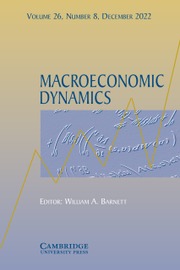No CrossRef data available.
Article contents
Heterogeneous biased expectations of young and old individuals: macroeconomic effects and policy implications
Published online by Cambridge University Press: 21 October 2024
Abstract
This paper examines the effects of heterogeneous biased expectations between the young and old on business cycles and explores its policy implications. Empirical findings reveal that individuals, particularly the young, can have more optimistic or pessimistic views about the future state of the economy compared to the data-generating measure. This study relates these results to the learning-from-experience literature, which suggests that individuals, particularly the young, place greater weight on recent observations when forming their expectations. Incorporating household weighting schemes into a life-cycle learning model, I show that household sensitivity to recent observations amplifies the effects of economic shocks. However, the amplification effects become less extensive as the population ages due to the lower sensitivity of the old. My simulation results indicate that a 10 percentage point increase in the old population ratio leads to a 16 percent decrease in output volatility. Regarding policy implications, this paper suggests that the government spending multiplier declines by approximately 10 percent when the old population ratio rises by 10 percentage points due to weak amplification effects. Moreover, the weakened output effects deteriorate the welfare of the population, particularly that of the young.
Keywords
Information
- Type
- Articles
- Information
- Copyright
- © The Author(s), 2024. Published by Cambridge University Press

